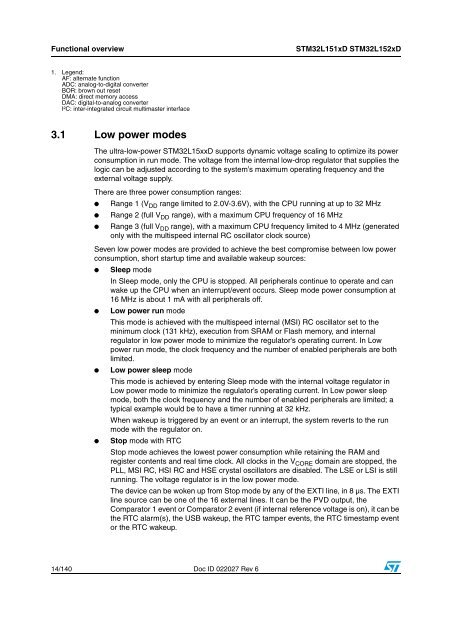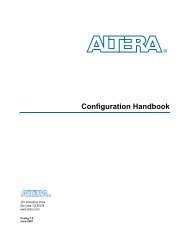Ultra-low-power 32-bit MCU ARM-based Cortex-M3, 384KB ... - Keil
Ultra-low-power 32-bit MCU ARM-based Cortex-M3, 384KB ... - Keil
Ultra-low-power 32-bit MCU ARM-based Cortex-M3, 384KB ... - Keil
You also want an ePaper? Increase the reach of your titles
YUMPU automatically turns print PDFs into web optimized ePapers that Google loves.
Functional overview<br />
STM<strong>32</strong>L151xD STM<strong>32</strong>L152xD<br />
1. Legend:<br />
AF: alternate function<br />
ADC: analog-to-digital converter<br />
BOR: brown out reset<br />
DMA: direct memory access<br />
DAC: digital-to-analog converter<br />
I²C: inter-integrated circuit multimaster interface<br />
3.1 Low <strong>power</strong> modes<br />
The ultra-<strong>low</strong>-<strong>power</strong> STM<strong>32</strong>L15xxD supports dynamic voltage scaling to optimize its <strong>power</strong><br />
consumption in run mode. The voltage from the internal <strong>low</strong>-drop regulator that supplies the<br />
logic can be adjusted according to the system’s maximum operating frequency and the<br />
external voltage supply.<br />
There are three <strong>power</strong> consumption ranges:<br />
● Range 1 (V DD range limited to 2.0V-3.6V), with the CPU running at up to <strong>32</strong> MHz<br />
● Range 2 (full V DD range), with a maximum CPU frequency of 16 MHz<br />
● Range 3 (full V DD range), with a maximum CPU frequency limited to 4 MHz (generated<br />
only with the multispeed internal RC oscillator clock source)<br />
Seven <strong>low</strong> <strong>power</strong> modes are provided to achieve the best compromise between <strong>low</strong> <strong>power</strong><br />
consumption, short startup time and available wakeup sources:<br />
● Sleep mode<br />
In Sleep mode, only the CPU is stopped. All peripherals continue to operate and can<br />
wake up the CPU when an interrupt/event occurs. Sleep mode <strong>power</strong> consumption at<br />
16 MHz is about 1 mA with all peripherals off.<br />
● Low <strong>power</strong> run mode<br />
This mode is achieved with the multispeed internal (MSI) RC oscillator set to the<br />
minimum clock (131 kHz), execution from SRAM or Flash memory, and internal<br />
regulator in <strong>low</strong> <strong>power</strong> mode to minimize the regulator's operating current. In Low<br />
<strong>power</strong> run mode, the clock frequency and the number of enabled peripherals are both<br />
limited.<br />
● Low <strong>power</strong> sleep mode<br />
This mode is achieved by entering Sleep mode with the internal voltage regulator in<br />
Low <strong>power</strong> mode to minimize the regulator’s operating current. In Low <strong>power</strong> sleep<br />
mode, both the clock frequency and the number of enabled peripherals are limited; a<br />
typical example would be to have a timer running at <strong>32</strong> kHz.<br />
When wakeup is triggered by an event or an interrupt, the system reverts to the run<br />
mode with the regulator on.<br />
● Stop mode with RTC<br />
Stop mode achieves the <strong>low</strong>est <strong>power</strong> consumption while retaining the RAM and<br />
register contents and real time clock. All clocks in the V CORE domain are stopped, the<br />
PLL, MSI RC, HSI RC and HSE crystal oscillators are disabled. The LSE or LSI is still<br />
running. The voltage regulator is in the <strong>low</strong> <strong>power</strong> mode.<br />
The device can be woken up from Stop mode by any of the EXTI line, in 8 µs. The EXTI<br />
line source can be one of the 16 external lines. It can be the PVD output, the<br />
Comparator 1 event or Comparator 2 event (if internal reference voltage is on), it can be<br />
the RTC alarm(s), the USB wakeup, the RTC tamper events, the RTC timestamp event<br />
or the RTC wakeup.<br />
14/140 Doc ID 022027 Rev 6

















